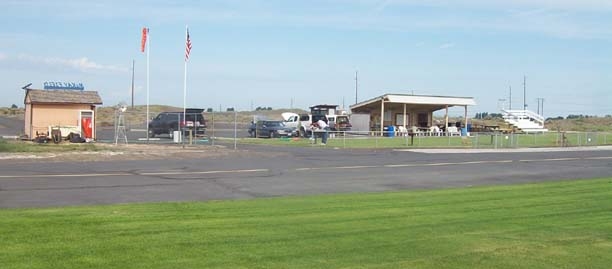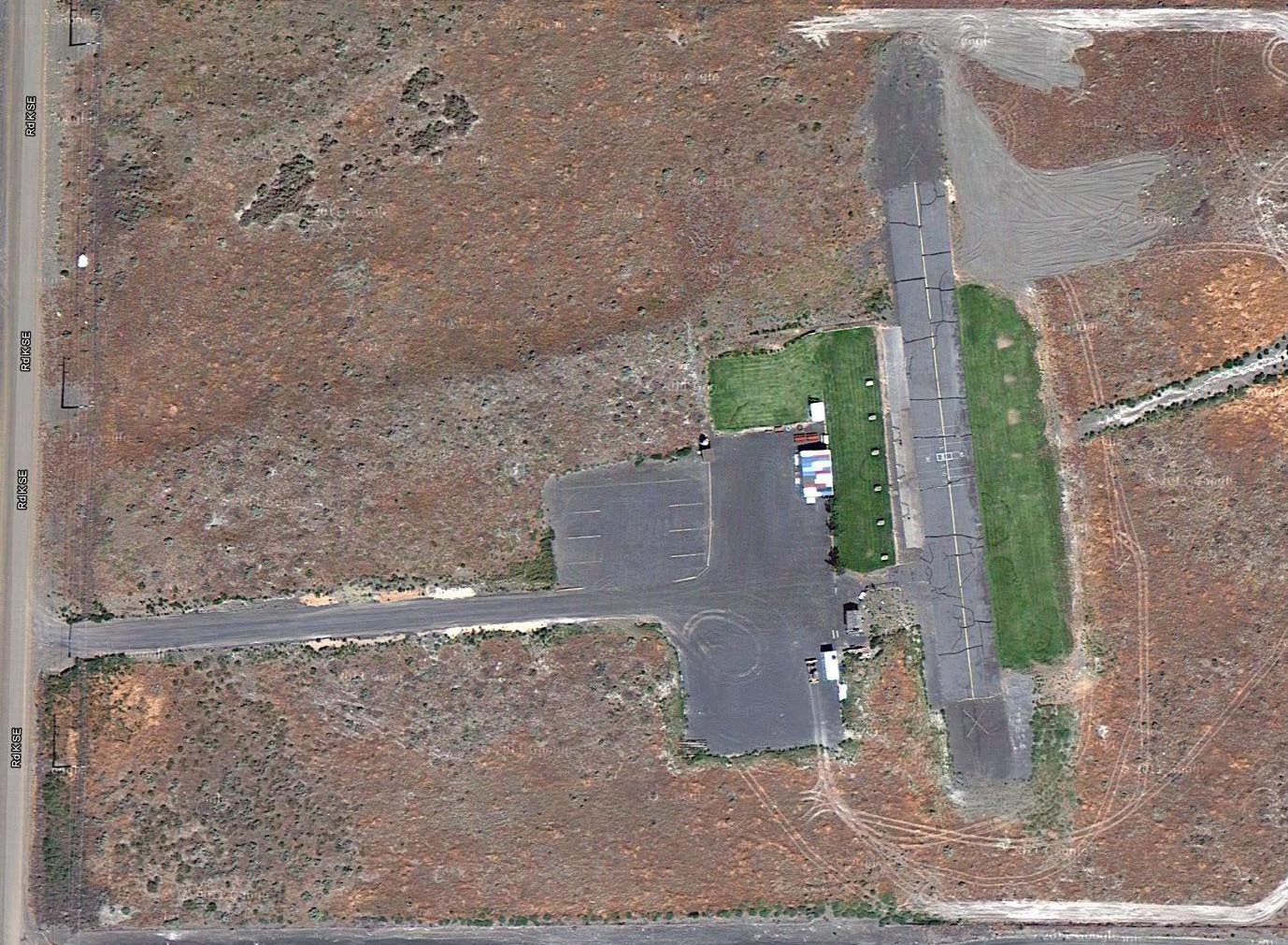McKay Field contains:
|
Access to the site is usually available to guests Sat. and Sun. between 10 AM and 1 PM, but the
gate to the field may be open at other times. MLRCM members have access to the site 24/7.
Pilots must be a MLRCM member (or a guest of a member) and be a current member of the AMA to fly at the site. Pilots are required to abide by the club’s flying site rules and AMA Safety Rules (posted at the site). |
Location & Driving Directions
LocationThe Casey McKay Model Aircraft Flying Field is approximately
2 miles south of Moses Lake at 1705 Road “K” SE
(Lat.47.06972-Long.119.25758) -- View Google Map
Driving Directions
From Downtown Moses Lake:
- South on Division St. (changes to Potato Hill Rd. at I-90 overpass);
- Turn East on Baseline E. Rd. at fire station; turn South on Rd. K SE at radio towers;
- Cross the RR tracks and continue South approx. 1.2 mi. to Casey McKay Flying Field.
- Travel south on Hwy 17 for approx. 1.3 mi.;
- Turn West on Potato Frontage Rd SE/Baseline East Rd.;
- Turn South on Rd. K SE at radio towers;
- Cross the RR tracks and continue South approx. 1.2 mi. to Casey McKay Flying Field.
Flying Site Rules
- Operation of RC model aircraft at this site is restricted to MLRCM Club members and their guests. If you are not a club member, obtain permission from a member before flying.
-
Each pilot operating an RC aircraft at this site must be a current AMA member.
- Exception) Non-AMA members can fly under some circumstances with direct supervision of an AMA member.
- Comply with AMA Safety Code (posted at this site()
- Fly all model aircraft only in designated flying area east of the “pilot area” adjacent to the west side of the runway. Do not fly over the building south of the RC runway.
- Secure frequency pin from club frequency board for your transmitter’s frequency before turning on your transmitter (Tx), this is to include 2.4Ghz radios. When you pick up the frequency pin, keep the pin on your Tx while it is in use. Return the pin to the board when you turn off your Tx after your flight. If you turn on your Tx without a pin and cause someone else’s plane to crash you are responsible for the damage. If you don’t put the pin on your Tx you will be fined.
- All radios used at this field for flying RC aircraft must be on aircraft frequency.
- A maximum of 4 model aircraft may be in the air at any one time.
- Pilots (and persons assisting pilots) may be on the runway only for take-offs, hand-launches and retrievals; and must announce these actions to other pilots.
- Pilots must be in the “pilot area” between the pits and the runway when flying. In addition, pilots must be at least 20 feet apart. Pilot stations (3-sided “cages”) are available and are recommended for use when flying.
-
Spectators must stay off the runway and normally will not be allowed in the pit area.
- Exceptions: (photographers, reporters, AMA officials, etc.) to this rule must obtain permission from the Club Safety Officer, or in his absence from a presiding Club officer.
- Do not fly over or near people.
- Pilots shall keep their model’s flight path east of the club’s runway except when taking off and landing.
- Point model away from spectator area when running engine (or electric motor) in pits. In addition, avoid running up the engine if positioned so that dust and debris will blow toward spectators.
- Mufflers are required on all model engines larger than .09 cu. in. displacement.
- The club Field Marshall or Safety Officer, or their designee, is authorized to deny flying privileges to any individual for just cause.
- All new pilots must go thru a brief orientation before flying at this site. Orientations will be conducted by the Safety Officer or a Board Member, or other appointed member.
Flying At AMA Chartered Club Sites
The continuing growth of model aviation has generated an increasing number of inquiries regarding AMA’s policy as it pertains to usage of flying sites by chartered clubs, their guests, and others. While it is not possible to state a policy that addresses every scenario imaginable, AMA has, for several decades, stressed to clubs the importance of conducting flying site activities in a manner that minimizes the risk of an accident which might result in “uncovered” liability to an AMA club, member and/or site owner.
AMA members and clubs pool their resources in order to obtain insurance for themselves and their flying site owners at very low rates. This is a key point to keep in mind when considering the use of club flying sites by non-AMA members. If a flying site owner relies on your insurance for an accident caused on its property by a non-AMA member, your money is being spent to finance the activities of someone who paid nothing for that benefit.
To preserve the availability of low cost insurance to your club and its site owner, the people who fly with your club should contribute their share of that cost. They can do so by becoming dues paying members of your AMA charter club as well. In the same vein, if the landowner for your club’s chartered club field has granted the club exclusive flying privileges, the club should ONLY allow AMA members and current members of the Model Aeronautics Association of Canada (MAAC) to fly at the field. If your club is flying on public land and it has not been granted exclusive flying rights by the public agency in charge, your club activities should be confined to AMA members, and you are not responsible for other (non-AMA) flier’s actions. Should the public agency be named as an additional insured, it has coverage only for the actions of your club, its members, and other visiting AMA members who are considered guests.
For non-AMA members wishing to experience a “hands-on” model flight, the Academy does allow this, on a one-time basis per person ONLY, (with the use of a Buddy Box system for RC). During this one-time flight, the club is protected through its liability coverage as long as the non-member’s supervised flying is in accordance with the AMA National Model Aircraft Safety Code(s). Under NO situation should the non-member’s equipment or aircraft be used.
ONLY AMA members are insured during this flight per the terms of the liability policy. This coverage is never transferable to the non-AMA member during the permitted one-time trial flight.
Should an accident occur during this one-time flight, the person providing the flight assistance must file an accident report.
Under the liability policy, the airplane is never insured and the non-AMA member is never insured during this flight.
Can someone be insured during training at a chartered club field and not be a regular AMA member?
Under the AMA Introductory Pilot Program, a non-AMA person may receive lessons during a 60-consecutive-day period under the direction of a designated AMA Instructor. The program information has been mailed to each chartered club. During supervised flight instruction, liability insurance is provided for the trainee for a 60-day period but only at the club site. Though the trainee will not receive a membership card, he/she is considered a member of the Academy while under the direct supervision of the currently registered designated Introductory Pilot. Introductory Pilots are charged with the responsibility to ensure that the trainees’ activities will be conducted in compliance with the AMA’s National Safety Code(s). Coverage under the Intro Pilot Program begins the day recorded on the Trainee Pilot Registration Form. To take advantage of the full 60 days of liability insurance, register the trainee after the non-flying instructional session(s) and prior to their first flying exercise at the club field.
Signing up Intro Pilots and trainees can be done at anytime on our Web site at www.modelaircraft.org/MembersOnly/ intropilotdesc.aspx. Forms are also available for download at www.modelaircraft.org/PDF-files/917.pdf.
The Academy appreciates your interest and promotion of the sport of modeling through implementation of training programs. If this document does not answer your questions regarding club insurance, guests, or trainee flying, call the Club Secretary at (765) 287-1256, extension 291, or correspond directly.

